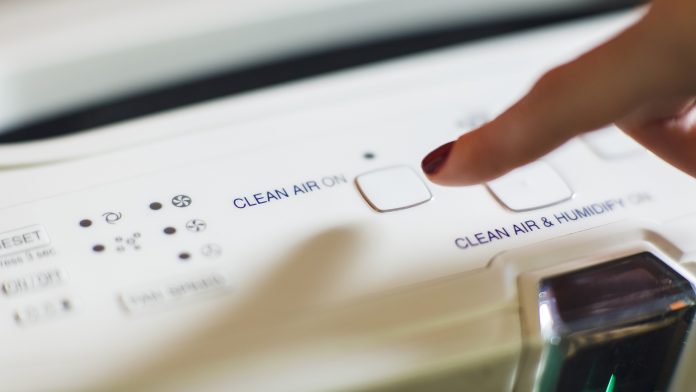
Digital editor, Monet Bailey examines the evolving role of air purification technology, particularly in the area of infection control.
Air purification technology rose in popularity during the COVID-19 pandemic; its powerful ability to remove airborne particles in a room attracted a wide audience, from consumers to healthcare professionals. Looking towards the future, how can air purification reduce the risk of infections and other conditions such as allergies in healthcare and at home?
Before the COVID-19 pandemic, air purifying devices were predominantly targeted towards allergy sufferers and asthmatics to reduce irritants, such as dust or pollen, circulating in the atmosphere; however, air purifiers are multifunctional and useful for mitigating the risk of infections.
Air purifiers are now available for domestic and commercial use. Commercially graded air purification devices normally come in two forms: as small standalone units or large units connected to an air handler unit (AHU) or heating, ventilation, and air conditioning (HVAC) unit. These can be found in medical, industrial, and commercial settings. These devices have also found themselves in consumer’s hands with many retailers selling compact air purifiers for home use.1
The role of air purification during COVID-19
A health document from Public Health Ontario2 outlines how severe acute respiratory syndrome coronavirus 2 (SARS-CoV-2) is transmitted via infectious respiratory particles. Evidence indicates that close contact with an infected individual is a leading factor in transmission, but lack of room ventilation can also contribute to susceptibility, highlighting why air purification played such a crucial role in the pandemic.
Portable air purifiers with a High-Efficiency Particulate Air (HEPA) filter (or a filter with a MERV ≥ 13) can remove SARS-CoV-2 virus-sized particles from indoor air. When used alone or in combination with existing ventilation systems, air purifiers can reduce SARS-CoV-2 particles over time, reducing aerosol transmission.
These devices should be used in conjunction with other control measures to reduce transmission risks, such as vaccinations, mask-wearing, and hand hygiene. Air purifiers are not substitutes for other public health measures and are recommended to be implemented in a multi-layered strategy.
Additional research from the University of Cambridge and Addenbrooke’s Hospital illuminates the capability of air purification in tackling airborne COVID-19.3 A team of doctors, scientists and engineers placed HEPA air filtration machines in COVID-19 wards to explore whether this technology could reduce airborne infectious particles. Following analysis, they found that the devices removed almost all traces of airborne SARS-CoV-2.

Researchers from Simon Fraser University found that air filters such as portable purification devices have a profound effect during pregnancy, reducing the negative impact of air pollution on pregnant women and their unborn children.
Can improving air quality reduce the risk of respiratory illness and other conditions?
Similar to the mechanism seen with the SARS-CoV-2 virus, air purifiers can tackle other viral infections like influenza by removing infectious respiratory particles. However, before this phenomenon of air purification and infectious diseases, these devices were used to improve respiratory symptoms and allergies.4
As the public breathes in more impurities caused by air pollution, more respiratory conditions and harmful diseases arise. One way to combat the effects of pollution is air purification devices in the home or workplace. Respiratory symptoms such as difficulty breathing, cough and upper airway congestion can all be exacerbated by harmful pollutants found in the air.
Pulmonologist Rachel Taliercio, DO, said: “By filtering out fine particles, purifiers help clean the air you breathe and lessen the potential negative effects of pollution. Purifiers have been shown to alter the blood chemistry in a way that may benefit heart health, too.”
One study by Simon Fraser University corroborated the positive role of air purification on the toxic effects of air pollution. Researchers found that air filters such as portable purification devices have a profound effect during pregnancy, reducing the negative impact of air pollution on pregnant women and their unborn children. In the study, the intervention group were allocated one or two HEPA filter air purifiers and the control group continued as normal. Four years later, the researchers measured full-scale intelligence quotient (FSIQ) in the children, finding that the offspring whose mothers used air purifiers had an average FSIQ of 2.8-points higher.5
Applying air purification technology in healthcare
COVID-19, and many other transmissible illnesses, are a big concern for healthcare systems around the world, including the National Health Service (NHS) in the UK.
The NHS’s ventilation guidelines advise that six air changes are conducted per hour in hospital wards.6 However, many hospitals struggle to achieve this target. This neglect has been named ‘structural under ventilation’ and is a result of poor existing ventilation systems in older NHS hospitals, prohibitive retrofit costs, and the disruption that a new HVAC installation would trigger.
Furthermore, the World Health Organization (WHO) recommends air purifiers to supplement ventilation systems. In a recent document named ‘Roadmap to improve and ensure good indoor ventilation in the context of COVID-19’,7 WHO outlines that adequate ventilation plays a key role in preventing and reducing infections in patient care areas.
Additionally, the UK SAGE committee recommended two technologies in November 2020 to combat COVID-19 transmission: fibrous filtration (HEPA) and germicidal UV (UVC). When these technologies are combined, they trap and destroy the COVID-19 virus.6
References
1. Air purifier. (2022, August 20). In Wikipedia. https://en.wikipedia.org/wiki/Air_purifier
2. Public Health Ontario (2022). https://www.publichealthontario.ca/-/media/documents/ncov/ipac/2021/01/faq-covid-19-portable-air-cleaners.pdf?la=en
3. University of Cambridge (November 2021). https://www.cam.ac.uk/research/news/air-filter-significantly-reduces-presence-of-airborne-sars-cov-2-in-covid-19-wards
4. Cleveland Clinic (October 2020). https://health.clevelandclinic.org/can-air-purifiers-improve-lung-heart-health/
5. Simon Fraser University (June 2022). https://www.sfu.ca/fhs/news-events/news/2022/reducing-air-pollution-can-support-healthy-brain-development.html
6. NHS Confederation (August 2021). Clean air is the NHS’s most powerful weapon against COVID-19 | NHS Confederation
7. World Health Organization (March 2021). https://www.who.int/publications/i/item/9789240021280
This article is from issue 23 of Health Europa Quarterly. Click here to get your free subscription today.
























